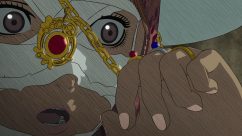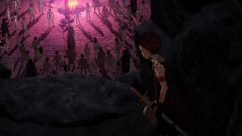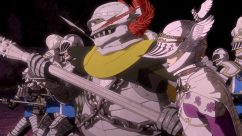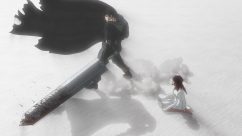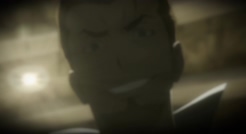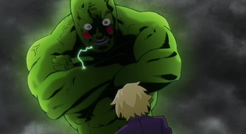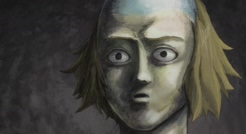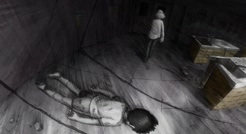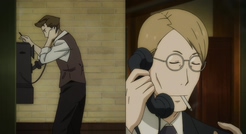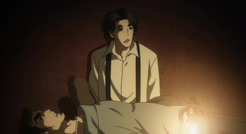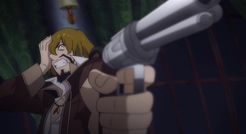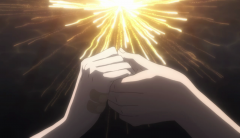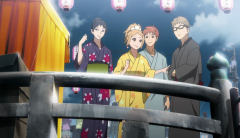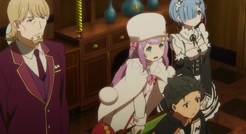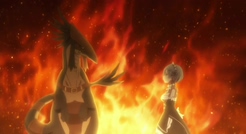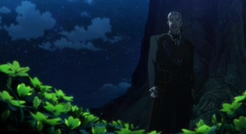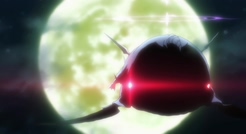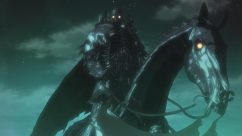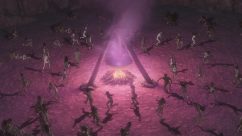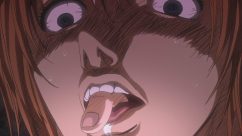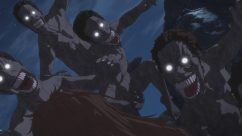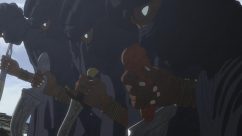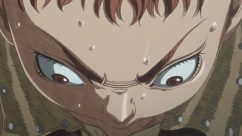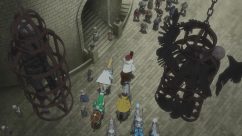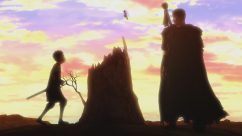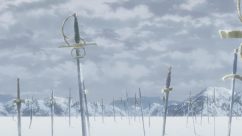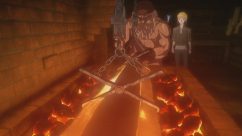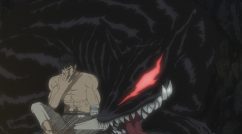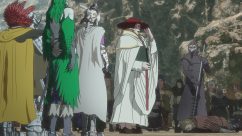I apologize for this very late review, but due to circumstances I didn’t have the means of watching the episode, and hence the week-long delay. I’ll try to at least leave a notification in case of such issues in the future, but otherwise will try to keep the posts steady. So let’s get right to it, shall we?
We get a recap of the ending scene of last episode, with the Demon Child warding off the spirits, and in turn making Casca the hailed princess of the cult. It appears that in these times of desperation, the cult members cling to anything that they can praise as a deity. The noteworthy thing here is that Casca shows a maternal instinct for the Child, as she tries to reach for it before it disappears. This stands as a stark contrast to Guts, who sees the child as a curse and an ugly reminder of his past.
Next we have a scene at the camp, with Luca being brave and assertive as ever. I always disliked Nina’s characterization, but she appears to be even more annoying in this series. Her selfish ways are highlighted here in an attempt to create some sort of a character arc for her in the future. The duo’s discussions are interrupted, as they are notified of an impending trial of another one of their compatriots.
Looks like we have ourselves a classic witch hunt here. Not unlike such similar occurrences in reality, these hunts are more about silencing unrest and class warfare than anything else. There are few tools more effective in oppression of a population, than an appeal to divine authority. Thankfully the masquerade is cut short by the sudden appearance of a certain Black Swordsman. Guts has well established himself as the king of entrances, and this instance is not any different. I really do enjoy his no-nonsense approach to information gathering, and when pushed he proceeds to lay down the authority very swiftly. Fans often forget that Guts is truly an antihero, with his mercenary background defining his sense of morality. He is single-minded in his approach, and not afraid of taking any necessary measures to achieve his goals. I like to note that the digital blood splatters were bearable in this scene, and did little to distract from the action.
Next we have a rush back to the campsite in order to fetch Casca. There is a quick overview of the state of constant fear that has enveloped the camp, as people are quick to sell each other out in order to avoid punishment. The knights’ preoccupation with the situation in Albion can only mean that the news of the full-scale Kushan invasion has not reached their ranks yet. This is exacerbated by the show jumping the gun, and expediting the assault on Windham as early as four episodes ago.
Nina proceeds to panic when Luca doesn’t make it back to the campsite, and makes another stupid decision to seek refuge in the cave of the cultists. I guess this can be excused, since from her perspective the chance of Luca being caught by the knights is actually very high, and this decision is made out of pure desperation. I never liked the “princess is in another castle” shtick, but here it serves to move the plot towards the eventual encounter.
I never fully understood the mechanics of Puck’s visibility to mortals. It was implied that those of closemind and narrow worldview would find it harder to see him, but here we are told that larger crowds further hide his presence. I guess things are more easily concealed when there is more commotion. There is also a shallow attempt at explaining Isidro’s backstory, but given the rapid pacing of the episode this can be excused, as it would’ve bogged down the flow if it was given too much focus. He might be a silly kid, but at least he’s honest and to the point. From his view it definitely seems as if he’s found himself quite a master in Guts, and there’s safety in being under his wing. Little does he know how much of a magnet Guts truly is to danger, and considering that he learned his skills firsthand in a mercenary camp, Gut’s utility as a sword instructor is at the very least highly questionable. Nevertheless, he pursues Nina and Casca towards the cave.
Next there is the reappearance of Joachim, as he spills the bean about the location and activities of the cultists. A soldier also breaks the news of Guts to a visibly shocked Farnese, as the main thing she was trying to avoid has finally come to find her. Her reluctance in facing Guts definitely plays a part in their decision to give priority to hunting the cultists. There is some irony in the fact that the gravitation of the common people to these cults is directly related to their struggles under the Holy See’s oppression. The tighter the grip, the heavier the backlash against it.
We’re welcomed back to the cave, and it seems that this episode has given it a livelier look, as a bright magenta color palette prevails the tone of the scene. There also appears to be some improvements to the textures, with the ground and the cave walls having a more detailed look to them. I personally always enjoyed the symbolism of the crown of thorns that they place on Casca, although I admit that it is more for show than pertaining to anything deep. Nina is being prepared to be sacrificed for the union of the Great Goat and Casca, who as we remember is being worshiped as an idol of the cult. The world of Berserk heavily revolves around the concept of sacrifice. The cave seems to be located within a certain interstice, as a place where the barrier between the physical world and the astral realm is particularly weak. This is further intensified by the presence of Casca, which yet again summons the ghosts of those who were sacrificed to possess the cultists.
Next we get a full-on zombie brawl, as the Iron Chain Knights converge on the location of the cave. Well, in reality it’s more of a slaughter than an actual battle. I like to take the time to say that I really enjoy the design of the visor on Farnese’s helmet, here portrayed with an even more exaggerated length than the manga. Isidro proves his worth, as he buys some time until Puck can fly and get Guts. It is revealed that the Great Goat is not really of any supernatural essence, but just a man donning a ceremonial goat head. This quickly changes as the Egg Apostle sires the Great Goat, and makes him a true apostle-spawn. I’ll be getting into the Egg Apostle’s story in later reviews.
I seriously thought that what ensues will be toned down, but lo and behold, we are greeted to yet another demonic rape attempt. I guess after the infamous Rape Horse I should be expecting the series to stick close to these specific elements of the source material. Here we have some familiar workaround female nudity, as well as a peculiar censorship of some violence. I think this is a good place to delve a little bit into the strange censorship laws placed on the Japanese media. The regulations regarding anime censorship are strangely specific, with varying levels of rationalizations. There is much leeway in the graphic portrayal of violence when the subject is considered “otherworldly”. This means that a zombie, monster, or any evil creature can be shown to be straight ripped apart, while human victims need to be toned down to either simple stabbing or details being subject to black bars and omissions. There are similar laws regarding nudity, and more specifically the male reproductive organ. As Toshio Maeda of Urotsukidōji fame came to realize back in the 80’s, a regular human penis can under no circumstance be portrayed in media, while any phallic or “penis-like appendage” is completely acceptable under article 175 of the Criminal Code of Japan. And hence, the inclusion of the snake penis.
As things seem to be reaching a critical level, we are greeted to another badass Guts entrance, this time in the form of what can only be called a ‘Batman moment’. He emerges from the shadows, swiftly maneuvering down to the pit, and making mince-meat out of the possessed cultists. The Dragonslayer dances with little resistance, as the cavelight gives a Sword of Moonlight blue hue to its blade. As we get passed the nasty goat circumcision, we are thrilled by a much-awaited reunion of our two estranged lovers, as their meeting gaze speaks much more than anything that could be uttered here.
Overall this one was a faster, denser, and dare I say better episode than the last few that we’ve had in Albion. There are many confrontations in store, and the stage is nearly set for one of the most iconic moments in the history of Berserk. I have my work cut out for me, as I’m jumping right into the next review as soon as this one is posted. Stay tuned for more, as I rush to make up for lost time.
~Bam~

